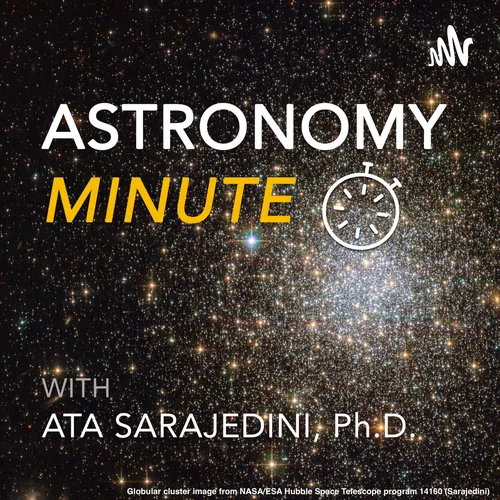
Astronomy Minute
Learn the basics of astronomy in one-to-two minute packets of concise information about specific topics. You are a busy person with a short attention span, and you want to learn about astronomical topics in a short amount of time. Your host Professor Ata is a PhD research astronomer and astrophysicist and a noted authority on stellar and galactic astronomy. I welcome your feedback at [email protected]. See the web site astronomyminute.org for more. The podcast logo is courtesy of Zachary Greathouse and shows a globular cluster photo taken by the author with the Hubble Space Telescope.
- Update frequency
- every 3 days
- Average duration
- 1 minutes
- Episodes
- 183
- Years Active
- 2020 - 2023

What is a White Dwarf Star?
A brief description of a white dwarf star, which is the end-state of a star that is less than 8 times the mass of Sun.

How do We Know the Ages of Stars?
A brief description of how we use the HR Diagram and the main sequence to measure the ages of stars in groups and clusters.

What is Seeing and the Resolving Power of a Telescope?
A brief description of seeing and the resolving power of a telescope.

Are Black Holes Cosmic Vacuum Cleaners?
A brief description of the true nature of black holes as highly localized sources of gravity and not cosmic vacuum cleaners.

What Was Here Before the Big Bang?
A brief description of what we think was here before the Big Bang. Short answer is that we don't know since "Science" is not equipped to answer questions where no data or information is available.

Are UFOs Aliens From Outer Space?
A brief description of my personal point of view regarding the possibility that UFOs harbor extraterrestrial beings visiting Earth.

What is the Milky Way Galaxy?
A brief description of the structure of the Milky Way galaxy - our galactic home.

What is the Hubble Law?
A brief description of the Hubble Law, now more formally known as the Hubble-Lemaitre Law.

What are Starburst Galaxies?
A brief description of starburst galaxies and why they are in star formation overdrive.

Is Science Absolute?
A brief description of whether the findings of science are _absolutely_ true. It could also have been entitled “Are Scientific Results Absolute?” and “Is the Scientific Method Absolute?”

What is Meant by Dimensional Analysis?
A brief description of what is meant by dimensional analysis. In short, the final units in a calculation must be correct for the calculation to be correct.

What are Sunspots and the Sunspot Cycle?
A brief description of the nature of sunspots and the sunspot cycle.

What is Meant by Einstein’s Theory of Relativity?
A brief description of Einstein’s Theories of Special Relativity and General Relativity?

A Description of the Mathematical Basis of Cause-and-Effect
A brief description of how we mathematically relate cause and effect in science. A short description of the equation of a straight line, y=m*x + b is also included.

How do Lunar and Solar Eclipses Happen?
A brief description of the different kinds of lunar and solar eclipses and how they happen.

What do I Need to Know About Planet Earth?
A brief description of what makes Earth unique from the other terrestrial planets - active plate tectonics, liquid water, a significant atmosphere, and the rich diversity of life.

So You Want to be a Professional Astronomer?
Some advice for anyone wanting to pursue professional astronomy/astrophysics as a career choice.

How do Atoms Absorb and Emit Light?
A brief description of how atoms absorb and emit particles of light known as photons based on the Bohr Model of the atom. This leads directly to the creation of absorption and emission lines in the s…

What are Some Well-Known Deep Sky Objects?
A brief description of some deep sky objects whose names you may have heard of in popular culture.

What is Meant by the Retrograde Motion of the Planets?
A brief description of what is meant by retrograde motion of the planets in the Solar System.